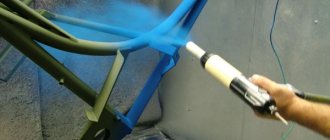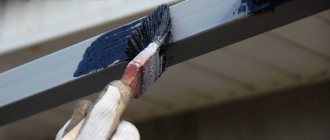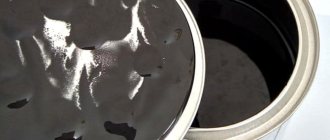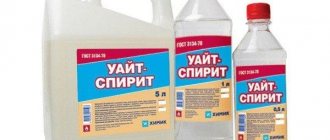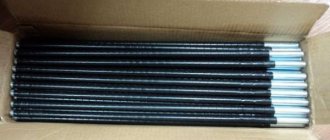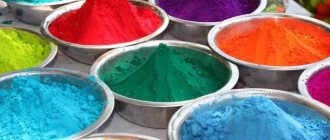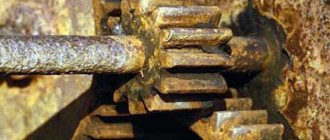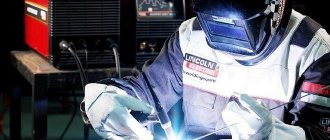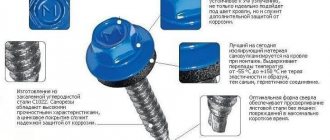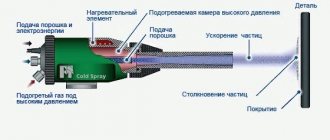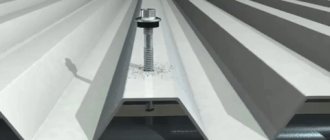Painting metal products is necessary to increase their service life, protect them from harmful factors, and it also gives the item a decorative appearance. Conventional liquid paints and varnishes do not always provide the required high level of protection; powder coating is considered more effective. The features of the tool and how to work with it will be discussed in detail below.
What are powder paints
Powder painting involves applying a composition by electrifying powder particles. The process can be achieved by external influence or by friction of particles against each other. The dyes are charged with a positive charge, and the surface to be painted has a negative charge, due to this the powder adheres to the base.
But in order for the process to be completed and the composition to be securely attached to the metal, a baking stage is required. To do this, the product is placed in a special polymerization chamber. When baked, the powder is fixed on the object and a durable film coating is created.
Powder painting involves applying a composition by electrifying powder particles.
Work order
The technology of powder coating of various metal products is a combination of activities. A detailed list of works includes an important stage - the preparation of the subject, the quality of which determines the result.
Preparation
You need to do the following:
The surface is thoroughly cleaned. To do this, a number of procedures are carried out:
- Mechanical removal of traces of rust and oxides from metal. If necessary, the old decorative layer is also removed. For this process, available tools are used: grinders, brushes, scrapers. If required, special washes are used. Sandblasting is considered the most effective, which, due to the action of abrasive particles under pressure, allows you to quickly remove all excess.
Sandblasting is currently considered the highest quality - Degreasing the base. For this, special alkaline or organic compounds are used. The solution used is applied to a rag, which is used to thoroughly wipe the surface. If necessary, the part is completely immersed in the solution.
- If possible, etching is performed. This method differs from the previous one in that it does not simply wash away contaminants, but affects their structure, facilitating better removal.
Degreasing and pickling are mandatory preparation steps
A conversion sublayer is formed. It is necessary to protect the surface from various pollutants. Compositions for this are selected based on the type of material being processed. Thus, chromium anhydride is used for aluminum parts, and iron phosphate is used for steel.
If required, passivation is performed. This process aims to consolidate the anti-corrosion coating.
You should know! The stages of preparation may vary depending on the products being processed and the scope of their application. Sometimes it is enough to carry out thorough cleaning and degreasing.
Applying dye
Powder coating of metal is carried out as follows:
- After preparation and drying, the elements to be painted are placed in the chamber. At the same time, they are fixed to the frame, which must be grounded. If work is done at home, then similar conditions are created.
Processing of the workpiece must be carried out in personal protective equipment. - To apply the powder, select a suitable sprayer. This procedure is performed in special protective clothing, a respirator and goggles.
- The detail is carefully processed. It is necessary to apply the particles evenly, covering all areas and maintaining the same distance to the surface to ensure a more uniform distribution.
During final heating, the temperature in the oven can reach up to 200ºС - The product moves into the oven. At this stage, it is important to achieve uniform heating, this will ensure the creation of a single polymer film. The temperature is selected individually.
Powder painting is considered complete. After 30 minutes, the metal product is removed from the oven and cooled; after complete cooling, the element is ready for use.
We also recommend watching this video:
What is painted with dry paints?
The powder is fixed in an oven for polymerization for 40-60 minutes, and is exposed to a temperature of 150-200 degrees. Not every material can withstand such high temperature exposure, which is the reason why use is limited to metal products. This option is not suitable for wooden and plastic materials.
Powder coating is available for the following items:
- Forged items used inside and outside the building also paint façade cassettes;
- Profiles made of aluminum and galvanized steel;
- For metal furniture;
- Housing parts in household appliances;
- Static elements in cars, also used for disks;
- For equipment used in sports;
- For industrial equipment.
Coating metal with powder paint is desirable when high resistance to rust formation on metal structures is required. Also, if operating conditions involve exposure to chemicals and mechanical stress, then the layer will help create an optimal barrier against such influences.
Coating metal with powder paint is desirable when high resistance to rust formation on metal structures is required.
Oven polymerization
To harden, powder paint must be heated to a certain temperature. Basically it is from 160 to 230 degrees.
The time spent in the oven will depend on the size of the part, its shape and thickness. The instructions for the powder will indicate the heating time and temperature. It is worth considering that the time indicated is that the part is in the oven at a certain temperature. The oven heating time will not be included here. Thus, the desired temperature is first reached and only then the time countdown begins.
The essence of the method
Powder painting technology means that a thin layer of coating is applied, which looks like one with the material. This metal coating technology is used in industry to paint a variety of objects made from metal materials.
Initially, the process of covering the surface of the product with paint particles is carried out using a spray gun. Application occurs using air pressure, and the powder is held to the base due to an electrical reaction when opposing charges collide. Afterwards, high-temperature exposure is required to start the polymerization process.
As a result, the paint leaves a thinning film that can withstand high temperatures and sunlight. It is difficult to leave scratches on the layer, so the coating lasts for many years. The layer is also beautiful.
Application occurs using air pressure, and the powder is held to the base due to an electrical reaction when opposing charges collide.
Disadvantages of powder coating
- The powder is melted at temperatures above 150 0C, which makes it impossible to paint wood and plastic.
- It is difficult to apply a thin layer of paint.
- Equipment for dry painting is highly targeted. In large ovens it is ineffective to paint small parts, and in a small oven it is impossible to paint a large surface area.
- A separate container must be used for each color.
- It is difficult to paint irregularly shaped objects or prefabricated structures.
- Equipping a painting line requires a large investment.
- If defects appear on the surface, they cannot be eliminated locally; the entire product will have to be repainted.
- There is no possibility to do tinting; you can only use factory paints.
Methods of working with powder paint
The operating principle of special devices for applying powder paint so that it is charged with the required electrical charge is different. So there are two types of operation of a spray gun:
- Electrostatic, in this tool, passing through the nozzle, the powder is charged when it touches the electrode, which is exposed to a negative voltage of 10,000 Volts;
- Tribostatic, in this case a pistol with a long barrel is used. An abrasive material is fixed inside, when the paint particles rub against each other and receive the desired charge.
An abrasive material is fixed inside, when the paint particles rub against each other and receive the desired charge.
Priming before painting
To ensure that the paint lasts as long as possible, it is recommended to prime the surface first. There are two types of soil: with zinc content and without zinc. For ferrous metal, it is best to use zinc primer. And, for example, for aluminum without zinc.
There are also types of powders that cannot be combined with priming.
Advantages and disadvantages
Painting an aluminum profile or other metal product with a powder composition has the following advantages:
- Reducing the number of layers of painting, so the process can be carried out quickly, and the cost of the item becomes lower;
- Environmentally friendly work, the production process is safe for the master, when exposed to high temperatures, harmful substances do not exceed the norm;
- There are no thinners in the composition, so micropores and cavities are not formed, and shrinkage is low;
- Low consumption of the product; there is also no need to allocate a separate area for drying the layer;
- Low level of explosion and fire hazard;
- The layer is hard, so the item can be transported without creating additional protection;
- High resistance to many aggressive influences and fuels and lubricants;
- A variety of colors, more than 5 thousand shades of paint are presented.
The description of the composition cannot be left without mentioning the disadvantages of the type; the first disadvantage is the inaccessibility of use for plastic and wooden objects. Other negative points:
- The equipment used is narrowly targeted; it is not economically profitable to dry small items in large ovens, and large items cannot be placed in small ovens;
- It is not easy to distribute the composition into complex shaped structures;
- High cost of necessary equipment;
- You cannot tint the composition; only the options presented in the palette are applicable.
There is also a drawback to the service in that it will not be possible to remove the application defect only in this area; you will have to completely remove the coating and apply a new layer.
The layer is hard, so the item can be transported without creating additional protection.
Areas of application
Areas of application of powder painting technology:
- processing of glass panels, MDF sheets;
- powder coating of metal products;
- painting products made of natural and artificial stone, ceramics;
- aluminum coating.
Painting car rims (Photo: Instagram / polimerka22)
Powder paint colors for metal
The color palette of this product pleases with its diversity. There are about 5,000 shades available, so choosing the right option if you decide to color it won’t be difficult. It is convenient to use the RAL catalog for selection.
But you won’t be able to add pigment to change the color; you can only use a ready-made version.
The color palette of this product pleases with its diversity.
Required materials and equipment
Powder painting of metal products at home is difficult due to the fact that special equipment is required. But often the business plan of auto repair shops includes the presence of the necessary line for such painting, because powder paint is often used specifically for cars.
The following equipment is required:
- A polymerization chamber, it is possible to make it yourself, but the process requires certain knowledge;
- Powder sprayer.
Powder painting of metal products at home is difficult due to the fact that special equipment is required.
Dry painting equipment
In powder coating, applying the paint is not the final step. In order for the polymer to adhere to the surface, it is heated in ovens. The powder coating line consists of:
- chambers for applying powder. In this sealed chamber, the coloring agent is applied to the metal;
- electrostatic sprayer for applying powder. Thanks to static electricity created by a high voltage source, paint is evenly applied to structures of any shape;
- polymerization chambers. It provides a constant temperature and is equipped with a ventilation system. In it, the process of paint polymerization and its uniform distribution over the product takes place;
- compressor. It is designed to create a certain pressure in the painting chamber;
- devices for transporting metal products. Heavy and large painted products must be transported carefully so that the powder does not fall off. This is provided by special carts moving along the monorail.
Surface preparation
You can paint the surface yourself with a powder composition if you know all the stages of the work. The preparatory part is important; it is necessary to clean the base from all types of dirt, and corrosion must be removed. Old coverings are also completely removed. After degreasing is carried out, a primer solution is applied. Passivation will be required to prevent the formation of rust.
Old coverings are also completely removed.
Powder painting process
- The painting process should take place in a very well-lit room, and an LED flashlight should be at hand.
- Before painting, you need to examine the surface for the presence of depressions and start painting from them.
- Before applying a layer on the desired surface, you need to start spraying a little to the side until a uniform cloud forms.
Plan your paint application paths in advance. It is necessary to ensure that the surface is painted in one pass. The gun is held at a distance of 15-20 cm. If the distance is too close, then the gun may also be grounded and will not allow for quality painting. If, on the contrary, you hold the gun further, then the charged powder particles will look for a closer grounded object.
Applying paint
Powder paint for metal is easy to apply; follow the steps below:
- Using a sprayer, distribute the powder in an even layer over the base, making sure that the distance between the tool and the object is the same at all times;
- Electrical voltage promotes a tight fit of particles to the surface;
- The remaining powder can be collected and reused after painting.
Electrical voltage helps the particles adhere tightly to the surface.
Degassing
Air bubbles can form on the surface of various metals. If they are not removed before painting, then air will escape through the paint, creating a path for water to penetrate into the bare metal.
Subsequently, corrosion will form. To prevent this, degassing is carried out using the following methods:
- heat the surface above the solidification temperature;
- powder paints and primers that take longer to dry and are able to remove these gases;
- special soil that can hold gas inside;
Main stages of coloring
Coloring should be carried out according to technology, you will need to perform the following steps:
- The foundation is being prepared.
- Paint is applied by spray.
- The painted product is sent to the oven; it is important to set the heating temperature correctly; usually the manufacturer indicates the required parameters in the instructions. It also selects the heating time.
- The object must cool down; it can cool in the open air.
Polyester types of paints are suitable for working with items used outdoors, and they are better able to withstand external factors. Epoxy is more often chosen for interior metal finishing.
It is important to set the warm-up temperature correctly; usually the manufacturer indicates the required indicators in the instructions.
Making your own oven
To create such a stove yourself, you will need the following list of materials:
- Profile pipes
- Fireproof thermal insulation (basalt slab is ideal)
- Sheet metal for cladding (ordered on any online resource or in a hardware store in the required quantity and size)
- Tangential fan and heating elements
Build process
- Initially, it is necessary to create a frame for the future furnace from profile pipes, then insulation is laid into it.
- The walls are sheathed on the inside using sheet metal; gypsum fiber should be used for sheathing on the outside.
- To create convection, a tangential fan is used, a wide inlet is created for it, and, accordingly, a narrow outlet is created to create draft.
- The fan is inserted into the chamber, its task is to suck in air from above, and then direct it through the heating elements, then the air will flow along the bottom and disperse throughout the chamber. The heating elements must be installed along the walls located opposite each other and connected, having previously been distributed into phases.
- Further, after installation, the heating elements are closed, only the fan is left open, the main part should be outside the chamber, this will avoid melting of the winding.
- At the final stage, an electrical panel is installed to which the camera will be connected. It is recommended to entrust this step to a specialist to avoid incorrect installation.
Thus, the equipment will be no worse than purchased. During the heating period of the chamber, the furnace power will be 12 kW, during operation only 6 kW. This device can use more than just electricity as an energy carrier.
Gas and diesel fuel are allowed, but the design changes slightly; it is necessary to install a gas meter, just as when working with diesel fuel, the installation of additional equipment will be required.
Baking temperature
The temperature for baking can vary between 150 and 220 degrees, and is determined by the type of coloring agent. Some paints can be used for glass and ceramics, in which case the degrees are usually set at 180 degrees. For metal bases, heating up to 220 degrees is possible.
The temperature for baking can vary between 150 and 220 degrees, and is determined by the type of coloring agent.
Safety during work
First of all, you should take care of the form. You need to protect yourself from possible paint getting on your hair, beard or skin. To do this, you should get a hat and clothes with long sleeves and pants. It would be better if it was a special uniform.
You should also avoid inhaling dust. To do this, it is necessary to check the presence of working ventilation systems and be sure to use a respirator to protect the respiratory system. When removing parts after polymerization, wear gloves to avoid getting cut or burned.
Consumption per 1 m2
The average coating consumption is indicated on the packaging. But it is influenced by various factors that arise during work:
- The type of material being painted, smooth substrates will require less product than rough ones;
- The shape of the object, the more complex it is, the more paint will have to be applied;
- The density level of the composition, the higher it is, the greater the consumption;
- Layer thickness;
- The skill of the master, an inexperienced painter will apply more powder to obtain a more even coating.
The average coating consumption is indicated on the packaging.
Powder coating of metal: rules and recommendations
There are a number of recommendations that should be followed in order to carry out work safely and efficiently:
- The master must wear protective clothing and a respirator;
- You should not set the sprayer to increased air supply so that it does not fail too quickly;
- Grounding must be done;
- Mixing different shades of paint is unacceptable;
- The composition is stored in a warm and dry place;
- The technological process must be performed correctly to avoid defects in the coating.
You should not put the sprayer on increased air supply so that it does not fail too quickly.
Powder coating gives good results in protecting the base and is durable. It is important to purchase powder made in accordance with GOST, then it will be safe and of high quality, so you should request a certificate of conformity from the seller.
Benefits of powder coating
- Minimum amount of waste. Coloring using high-quality equipment gives an efficiency of up to 98%.
- The sanitary and hygienic conditions there are changing for the better. This is an environmentally friendly technology, in which even in the oven the concentration of volatile substances does not reach the maximum permissible standards.
- No solvents are used, which results in less shrinkage and virtually no pores on the surface of the product.
- More economical use of material when painting. The powder coating hardens within half an hour and allows for a thicker, single-layer coating. Savings also lie in the absence of the need to maintain large production areas to dry the product in air. The harder powder coating is not damaged during transportation, which reduces packaging costs.
- The powder-painted surface is UV resistant, has electrical insulating and anti-corrosion properties.
- Powder paint makes it possible to create a palette of more than 5,000 colors.
- Reduced degree of explosion and fire hazard in production.
